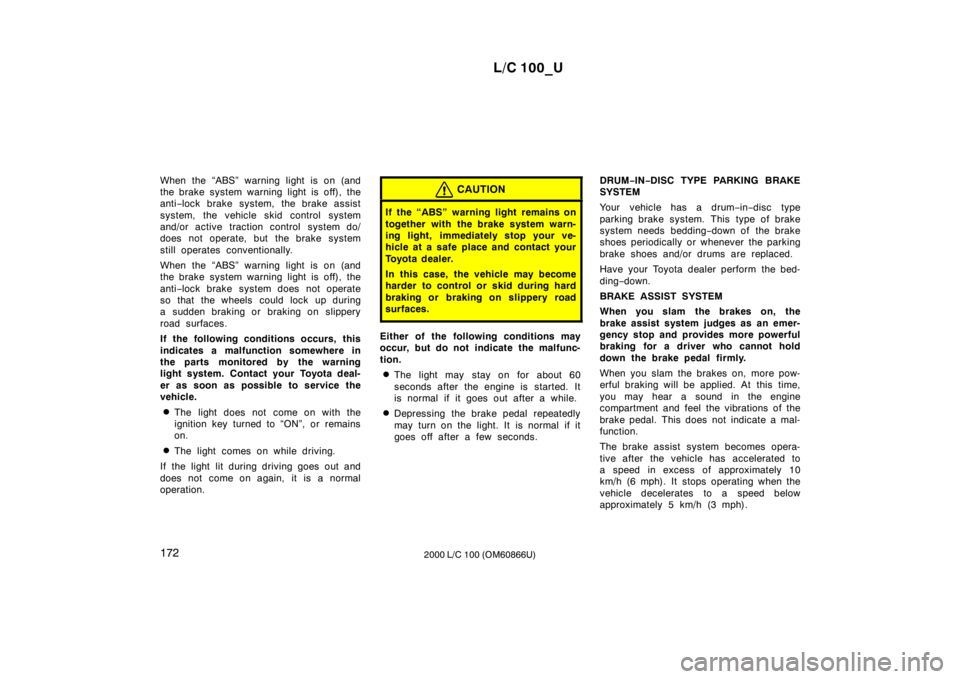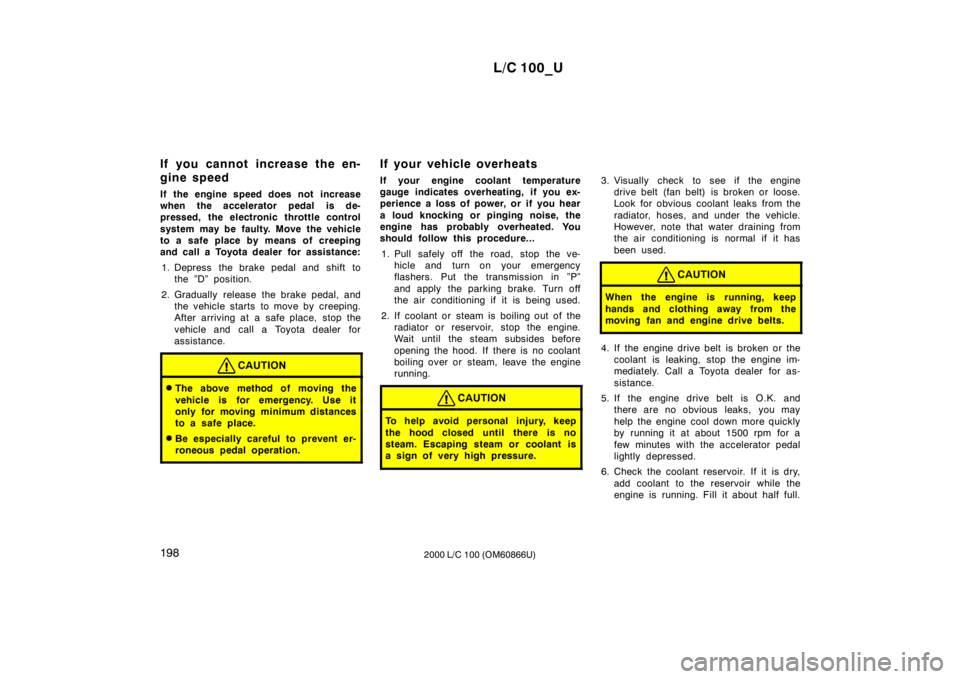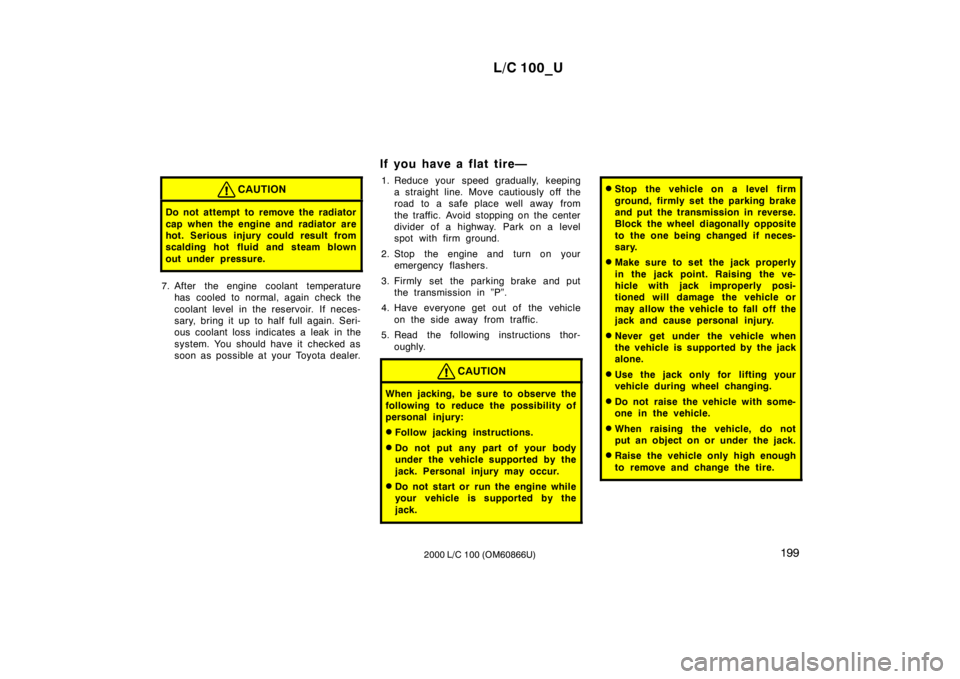2000 TOYOTA LAND CRUISER stop start
[x] Cancel search: stop startPage 150 of 235

L/C 100_U
172 2000 L/C 100 (OM60866U)
When the “ABS” warning light is on (and
the brake system warning light is off), the
anti
−lock brake system, the brake assist
system, the vehicle skid control system
and/or active traction control system do/
does not operate, but the brake system
still operates conventionally.
When the “ABS” warning light is on (and
the brake system warning light is off), the
anti −lock brake system does not operate
so that the wheels could lock up during
a sudden braking or braking on slippery
road surfaces.
If the following conditions occurs, this
indicates a malfunction somewhere in
the parts monitored by the warning
light system. Contact your Toyota deal-
er as soon as possible to service the
vehicle.
� The light does not come on with the
ignition key turned to “ON”, or remainson.
� The light comes on while driving.
If the light lit during driving goes out and
does not come on again, it is a normal
operation.
CAUTION
If the “ABS” warning light remains on
together with the brake system warn-
ing light, immediately stop your ve-
hicle at a safe place and contact your
Toyota dealer.
In this case, the vehicle may become
harder to control or skid during hard
braking or braking on slippery road
surfaces.
Either of the following conditions may
occur, but do not indicate the malfunc-
tion. � The light may stay on for about 60
seconds after the engine is started. It
is normal if it goes out after a while.
� Depressing the brake pedal repeatedly
may turn on the light. It is normal if it
goes off after a few seconds. DRUM
−IN −DISC TYPE PARKING BRAKE
SYSTEM
Your vehicle has a drum −in −disc type
parking brake system. This type of brake
system n eeds bedding −down of the brake
shoes periodically or whenever the parking
brake shoes and/or drums are replaced.
Have your Toyota dealer perform the bed-
ding −down.
BRAKE ASSIST SYSTEM
When you slam the brakes on, the
brake assist system judges as an emer-
gency stop and provides more powerful
braking for a driver who cannot hold
down the brake pedal firmly.
When you slam the brakes on, more pow-
erful braking will be applied. At this time,
you may hear a sound in the engine
compartment and feel the vibrations of the
brake pedal. This does not indicate a mal-
function.
The brake assist system becomes opera-
tive after the vehicle has accelerated to
a speed in excess of approximately 10
km/h (6 mph). It stops operating when the
vehicle decelerates to a speed below
approximately 5 km/h (3 mph).
Page 162 of 235

L/C 100_U
198 2000 L/C 100 (OM60866U)
If you cannot incr
ease the en-
gine speed
If the engine speed does not increase
when the accelerator pedal is de-
pressed, the electronic throttle control
system may be faulty. Move the vehicle
to a safe place by means of creeping
and call a Toyota dealer for assistance:
1. Depress the brake pedal and shift to the ”D” position.
2. Gradually release the brake pedal, and the vehicle starts to move by creeping.
After arriving at a safe place, stop the
vehicle and call a Toyota dealer for
assistance.
CAUTION
�The above method of moving the
vehicle is for emergency. Use it
only for moving minimum distances
to a safe place.
� Be especially careful to prevent er-
roneous pedal operation.
If your vehicle overheats
If your engine coolant temperature
gauge indicates overheating, if you ex-
perience a loss of power, or if you hear
a loud knocking or pinging noise, the
engine has probably overheated. You
should follow this procedure...
1. Pull safely off the road, stop the ve- hicle and turn on your emergency
flashers. Put the transmission in ”P”
and apply the parking brake. Turn off
the air conditioning if it is being used.
2. If coolant or steam is boiling out of the radiator or reservoir, stop the engine.
Wait until the steam subsides before
opening the hood. If there is no coolant
boiling over or steam, leave the engine
running.
CAUTION
To help avoid personal injury, keep
the hood closed until there is no
steam. Escaping steam or coolant is
a sign of very high pressure.
3. Visually check to see if the engine drive belt (fan belt) is broken or loose.
Look for obvious coolant leaks from the
radiator, hoses, and under the vehicle.
However, note that water draining from
the air conditioning is normal if it has
been used.
CAUTION
When the engine is running, keep
hands and clothing away from the
moving fan and engine drive belts.
4. If the engine drive belt is broken or thecoolant is leaking, stop the engine im-
mediately. Call a Toyota dealer for as-
sistance.
5. If the engine drive belt is O.K. and there are no obvious leaks, you may
help the engine cool down more quickly
by running it at about 1500 rpm for a
few minutes with the accelerator pedal
lightly depressed.
6. Check the coolant reservoir. If it is dry, add coolant to the reservoir while the
engine is running. Fill it about half full.
Page 163 of 235

L/C 100_U199
2000 L/C 100 (OM60866U)
CAUTION
Do not attempt to remove the radiator
cap when the engine and radiator are
hot. Serious injury could result from
scalding hot fluid and steam blown
out under pressure.
7. After the engine coolant temperature
has cooled to normal, again check the
coolant level in the reservoir. If neces-
sary, bring it up to half full again. Seri-
ous coolant loss indicates a leak in the
system. You s hould have it checked as
soon as possible at your Toyota dealer. If you have a flat tire—
1. Reduce your speed gradually, keeping a straight line. Move cautiously off the
road to a safe place well away from
the traffic. Avoid stopping on the center
divider of a highway. Park on a level
spot with firm ground.
2. Stop the engine and turn on your emergency flashers.
3. Firmly set the parking brake and put the transmission in ”P”.
4. Have everyone get out of the vehicle on the side away from traffic.
5. Read the following instructions thor- oughly.
CAUTION
When jacking, be sure to observe the
following to reduce the possibility of
personal injury: �Follow jacking instructions.
� Do not put any part of your body
under the vehicle supported by the
jack. Personal injury may occur.
� Do not start or run the engine while
your vehicle is supported by the
jack.
�Stop the vehicle on a level firm
ground, firmly set the parking brake
and put the transmission in reverse.
Block the wheel diagonally opposite
to the one being changed if neces-
sary.
� Make sure to set the jack properly
in the jack point. Raising the ve-
hicle with jack improperly posi-
tioned will damage the vehicle or
may allow the vehicle to fall off the
jack and cause personal injury.
� Never get under the vehicle when
the vehicle is supported by the jack
alone.
� Use the jack only for lifting your
vehicle during wheel changing.
� Do not raise the vehicle with some-
one in the vehicle.
� When raising the vehicle, do not
put an object on or under the jack.
� Raise the vehicle only high enough
to remove and change the tire.
Page 224 of 235

L/C 100_U
260 2000 L/C 100 (OM60866U)
16. HEAD (RH
−UPR) 20 A: Right−hand
headlight (high beam)
17. HEAD (LH −LWR) 10 A: Left−hand
headlight (low beam), front fog lights
18. HEAD (RH −LWR) 10 A: Right−hand
headlight (low beam)
19. MIRR 10 A: Power rear view mirror
20. SRS 15 A: SRS airbag system, seat
belt pretensioners
21. CIGAR 15 A: Cigarette lighter, car au-
dio system, power antenna
22. IGN 10 A: Multiport fuel injection sys-
tem/sequential multiport fuel injection
system, anti −lock brake system, SRS
airbag system, seat belt pretensioners,
discharge warning light
23. DOME 10 A: Interior lights, personal
lights
24. AHC −IG 20 A: No circuit
25. DIFF 20 A: Rear differential lock sys-
tem 26. GAUGE 15 A:
Gauges and meters,
service reminder indicators and warning
buzzer (except discharge, open door
and SRS airbag warning lights), back −
up lights, air conditioning system, elec-
tronically controlled automatic transmis-
sion system, wireless remote control
system, daytime running light system
27. WIPER 20 A: Windshield wipers and
washer, rear window wiper and washer
28. I/UP 7.5 A: Engine idle up system
29. FR FOG 15 A: Front fog lights
30. STOP 15 A: Stop lights, high mounted
stoplight
31. RR A.C 30 A: Air conditioning system
32. DEFOG 20 A: Rear window defogger
33. ECU −B 15 A: Power tilt and telescopic
steering system, daytime running light
system, theft deterrent system
34. TAIL 15 A: Tail lights, license plate
lights, parking lights, instrument panel
lights
35. AHC −B 15 A: No circuit
36. OBD 10 A: On−board diagnosis system
37. RR HTR 10 A: Air conditioning system 38. ECU
−IG 15 A: Anti−lock brake system,
shift lock system, power seats, power
antenna, power tilt and telescopic
steering system
39. PWR OUTLET 15 A: Power outlets
Fuses (type B)
40. ABS NO.1 50 A: Anti
−lock brake sys-
tem
41. AHC 50 A: No circuit
42. ACC 50 A: All components in ”PWR
OUTLET” fuse
43. ABS NO.2 40 A: Anti−lock brake sys-
tem
44. STARTER 30 A: Starting system
45. POWER 40 A: Power door lock control
system, power wi ndows, electric moon
roof, power seat, power tilt and tele-
scopic steering system
Fuses (type C)
46. MAIN 100 A: No circuit
47. ALT 140 A: All components in ”J/B
NO.2”, ”MIR HTR”, ”AM1 NO.1”, ”ACC”,
”CDS FAN”, ”HTR” and ”ABS NO.1”
fuses
48. J/B NO.2 100 A: All components in
”ECU −B”, ”FR FOG”, ”DEFOG”, ”AHC −
B”, ”TAIL”, ”STOP”, ”DOME”, ”POWER”,
”OBD”, ”RR A.C” and ”RR HTR” fuses